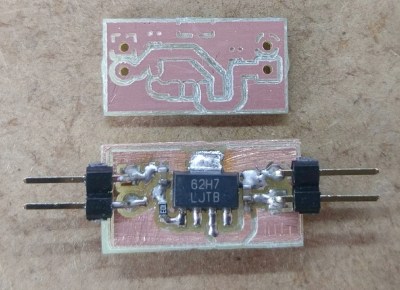Makerbot 3D printers were among the first to hit the market, so it makes sense that old and broken ones now litter the shelves of hackerspaces and home workshops alike. Rather than throw his one out, [Foaly] saw an opportunity to convert it to some sort of CNC machine. Given its lack of inherent rigidity and relatively weak motors, he opted to make a low-impact circuit board engraver which he appropriately calls the MakerbotCNC. We like the thought he put into this project, and it was clearly backed by plenty of experience.

Fortunately, his Makerbot Replicator 2 stemmed from a time when MakerBot was more open, meaning he could control the machine using a simple, open library. A little more open software handled his conversion of Gerber files to G-code. First tests drawing with a pen were successful, so he moved on to the carving head. He opted for an inrunner brushless motor to minimize dust getting into the motor but since these motors have a tendency to heat up he had to add fans to cool it. That still didn’t stop the heat from melting and bending his attempt at a 3D printed PLA carriage, so he switched it to a laser-cut MDF board to fix it. Finding the right collet proved tricky but eventually, he found the perfect fit was a collet clutch normally used to couple flex shafts to RC boat motors.
The result, as you can see was worth it. Using shallow passes, he can even cut carbon fiber parts.
While [Foaly] didn’t opt to replace more parts and go for a more powerful CNC, check out this 3D printer to CNC conversion which can cut wood, acrylic, and even aluminum.
















3d printer to CNC conversion? A 3d printer is a CNC. I guess a lot of the times CNC implies “mill,” though. It’s not like a lot of people would describe an inkjet printer as a CNC.
Yes. That’s annoying. Especialy in recent opensource CAM software field, which handles everything… “3d printing”, “laser cuting” and “CNC”. It’s lame that CAM people don’t know better… However i would be more concerned about rigidity of such setup than about nomenclature used to describe it.
As much as I love a board from OSH Park or similar, I love home-fabricated boards too. A dip in Liquid Tin for a minute helps me to solder more easily.
won’t this bend those tiny guide rails, or grind out the plastic sockets they’re in ? operator needs to be very careful.
The plastic sockets have some kind of Igus, and I don’t think the steppers have enough torque to bend the rails past the flexibility point where it would be permanently bent. But you are right, the operator still need to be careful, especially because even if it won’t damage the machine, even a small bending of the rails will lead to a significant displacement at the tool tip and cause precision issues. A good tool and slow enough movement solve this problem.
for the cost of PCB nowadays whats the point.
Hmmm… not having to wait for 3 weeks can be a good point?
Quick turnaround, prototyping and 1-off projects. I have a PCB router and I’m finding it really handy.
I’d strongly recommend a genuine spindle motor instead of converting an RC brushless motor. Not only are they designed for that duty, and have the right collet already fitted, most importantly they have bearings designed for minimal runout. The reduced vibration/eccentricity means you can do much finer features on the PCB. They’re really not expensive either, a 200 to 400 watt spindle is around $50 to $100.
You are right, I expect that bearings will start to become an issue at some point. For now it doesn’t seem that the runout caused by the bearings is significant compared to the other sources of imprecision (mainly the steppers and belts) but I check them regularly and I may try to replace them if necessary. I went with an RC brushless because that’s what I knew but I’ll definitely check out spindle motors if I need to replace it.
You will end up needing to replace it. Truthfully, you have a great frame for laser engraving. Milling though, not so much. If you really want this to work as a mill, you will end up needing to beef up the gantry system. I have a Millright M3, which was engineered for milling as an A-frame machine type and it has trouble keeping precision. Good luck with your project.
Which spindle are you referring to? For that price range the only ones I know are those Chinese DC motors with a ER11 coupling attached to the end. The ones coming with XCarve, etc. They only have lousy radial bearings and they are by no means proper spindles.
Sensitised copper boards and a laser engraver (or even normal copper boards with a layer of black paint)?
That should get you finer details and less damage to the board.
I’ve thought of this at first (and even bought a cheap laser to try it) but there are significant drawbacks to this solution. First, the process is messy, involving chemicals which are not easy to dispose of properly where I live (I already have liters of waste IPA mixed with FormLab’s resin that I don’t know how to handle yet). Second, this only allows to engrave the traces, drilling vias/throughholes and cutting the boards edge still require a CNC mill.